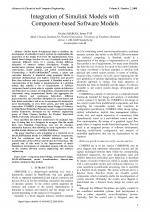| 2/2008 - 1 | View TOC | « Previous Article | Next Article » |
Integration of Simulink Models with Component-based Software ModelsMARIAN, N. |
| Extra paper information in |
| Click to see author's profile in |
| Download PDF |
Author keywords
component-based design, model-based design, MATLAB, Simulink, model transformation, discrete-time models, continuous-time models
References keywords
simulink(6), control(6), systems(5), software(4), embedded(4)
Blue keywords are present in both the references section and the paper title.
About this article
Date of Publication: 2008-06-02
Volume 8, Issue 2, Year 2008, On page(s): 3 - 10
ISSN: 1582-7445, e-ISSN: 1844-7600
Digital Object Identifier: 10.4316/AECE.2008.02001
Web of Science Accession Number: 000264815000001
SCOPUS ID: 77954668230
Abstract
Model based development aims to facilitate the development of embedded control systems by emphasizing the separation of the design level from the implementation level. Model based design involves the use of multiple models that represent different views of a system, having different semantics of abstract system descriptions. Usually, in mechatronics systems, design proceeds by iterating model construction, model analysis, and model transformation. Constructing a MATLAB/Simulink model, a plant and controller behavior is simulated using graphical blocks to represent mathematical and logical constructs and process flow, then software code is generated. A Simulink model is a representation of the design or implementation of a physical system that satisfies a set of requirements. A software component-based system aims to organize system architecture and behaviour as a means of computation, communication and constraints, using computational blocks and aggregates for both discrete and continuous behaviour, different interconnection and execution disciplines for event-based and time-based controllers, and so on, to encompass the demands to more functionality, at even lower prices, and with opposite constraints. COMDES (Component-based Design of Software for Distributed Embedded Systems) is such a component-based system framework developed by the software engineering group of Mads Clausen Institute for Product Innovation (MCI), University of Southern Denmark. Once specified, the software model has to be analyzed. One way of doing that is to integrate in wrapper files the model back into Simulink S-functions, and use its extensive simulation features, thus allowing an early exploration of the possible design choices over multiple disciplines. The paper describes a safe translation of a restricted set of MATLAB/Simulink blocks to COMDES software components, both for continuous and discrete behaviour, and the transformation of the software system into the S-functions. The general aim of this work is the improvement of multi-disciplinary development of embedded systems with the focus on the relation between control engineering and software engineering. |
| References | | | Cited By |
Web of Science® Times Cited: 3 [View]
View record in Web of Science® [View]
View Related Records® [View]
Updated today
SCOPUS® Times Cited: 5
View record in SCOPUS® [Free preview]
View citations in SCOPUS® [Free preview]
[1] Modelling of Switched Mode Fly-back Supply for Engineering Education, TRIP, N. D., LUNGU, S., POPESCU, V., Advances in Electrical and Computer Engineering, ISSN 1582-7445, Issue 1, Volume 10, 2010.
Digital Object Identifier: 10.4316/aece.2010.01018 [CrossRef] [Full text]
[2] Considerations on VoIP Throughput in 802.11 Networks, POTORAC, A. D., Advances in Electrical and Computer Engineering, ISSN 1582-7445, Issue 3, Volume 9, 2009.
Digital Object Identifier: 10.4316/aece.2009.03009 [CrossRef] [Full text]
[3] Post-processing of Deep Web Information Extraction Based on Domain Ontology, LIU, L., PENG, T., Advances in Electrical and Computer Engineering, ISSN 1582-7445, Issue 4, Volume 13, 2013.
Digital Object Identifier: 10.4316/AECE.2013.04005 [CrossRef] [Full text]
[4] Mechatronics: A Study on Its Scientific Constitution and Association with Innovative Products, Cintra Faria, Ana Carolina, Barbalho, Sanderson César Macêdo, Applied System Innovation, ISSN 2571-5577, Issue 4, Volume 6, 2023.
Digital Object Identifier: 10.3390/asi6040072 [CrossRef]
[5] Compositional translation of simulink models into synchronous BIP, Sfyrla, Vassiliki, Tsiligiannis, Georgios, Safaka, Iris, Bozga, Marius, Sifakis, Joseph, International Symposium on Industrial Embedded System (SIES), ISBN 978-1-4244-5839-4, 2010.
Digital Object Identifier: 10.1109/SIES.2010.5551374 [CrossRef]
Disclaimer: All information displayed above was retrieved by using remote connections to respective databases. For the best user experience, we update all data by using background processes, and use caches in order to reduce the load on the servers we retrieve the information from. As we have no control on the availability of the database servers and sometimes the Internet connectivity may be affected, we do not guarantee the information is correct or complete. For the most accurate data, please always consult the database sites directly. Some external links require authentication or an institutional subscription.
Web of Science® is a registered trademark of Clarivate Analytics, Scopus® is a registered trademark of Elsevier B.V., other product names, company names, brand names, trademarks and logos are the property of their respective owners.
Faculty of Electrical Engineering and Computer Science
Stefan cel Mare University of Suceava, Romania
All rights reserved: Advances in Electrical and Computer Engineering is a registered trademark of the Stefan cel Mare University of Suceava. No part of this publication may be reproduced, stored in a retrieval system, photocopied, recorded or archived, without the written permission from the Editor. When authors submit their papers for publication, they agree that the copyright for their article be transferred to the Faculty of Electrical Engineering and Computer Science, Stefan cel Mare University of Suceava, Romania, if and only if the articles are accepted for publication. The copyright covers the exclusive rights to reproduce and distribute the article, including reprints and translations.
Permission for other use: The copyright owner's consent does not extend to copying for general distribution, for promotion, for creating new works, or for resale. Specific written permission must be obtained from the Editor for such copying. Direct linking to files hosted on this website is strictly prohibited.
Disclaimer: Whilst every effort is made by the publishers and editorial board to see that no inaccurate or misleading data, opinions or statements appear in this journal, they wish to make it clear that all information and opinions formulated in the articles, as well as linguistic accuracy, are the sole responsibility of the author.



